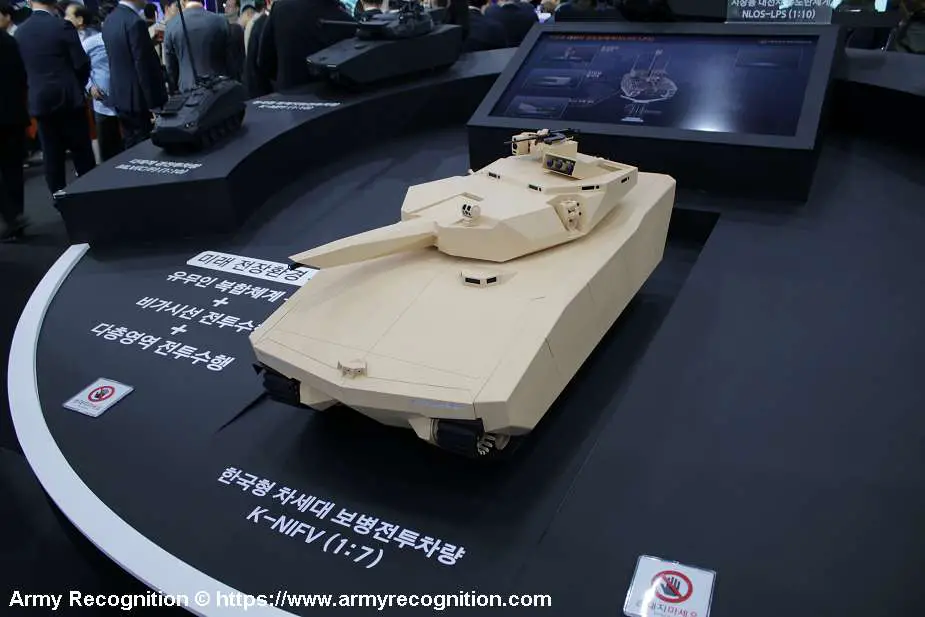Breaking news
ADEX 2023: Hanwha Aerospace Introduces K-NIFV Project South Korea's New K21 IFV Successor.
At the ADEX 2023 Aerospace and Defense Exhibition in South Korea, Hanwha Aerospace unveiled a new development of a tracked armored vehicle, the K-NIFV (Korean New Infantry Fighting Vehicle). This new IFV project comes as a response to the South Korean army's need to replace the K21 IFV (Infantry Fighting Vehicle), which has been in service with the South Korean army since 2009.
Follow Army Recognition on Google News at this link

Scale model of Hanwha Aerospace K-NIFV Korean New Infantry Fighting Vehicle at ADEX 2023, the Aerospace and Defense Exhibition in South Korea. (Picture source Army Recognition)
The K-NIFV (Korean New Infantry Fighting Vehicle) is based on the AS21 Redback's design, an IFV (Infantry Fighting Vehicle) also designed by Hanwha Defense and chosen by the Australian army to succeed the M113AS4. However, the K-NIFV boasts several enhancements, particularly in protection, mobility, and weaponry.
In terms of design, the K-NIFV mirrors the AS21 Redback, featuring a powerpack at its front, a turret in the middle, and a rear troop compartment. Weighing in at 42 tons, it will accommodate a three-member crew and up to eight infantry personnel.
The K-NIFV's turret will be equipped with a 40mm CTA cannon, a product of SNT Dynamics. The cannon will be able to fire three ammunition types: High Explosive, armor-piercing, and training rounds. Additionally, the K-NIFV will feature a remotely operated weapon station on the turret roof, armed with a 12.7mm heavy machine gun. An anti-tank missile launcher station, armed with three TAipers missiles, will also be integrated. The TAipers missile, also referred to as Cheongeom, is an advanced missile designed for light attack helicopters.
The TAipers missile boasts a dual-mode seeker for both day and night operations. Its unique features, such as fiber optic data and Man-In-The-Loop (MITL) operation, allow for both direct and indirect targeting. With a maximum range of 8 km, it can penetrate up to 1,000 mm of steel.
For protection, the K-NIFV will incorporate cutting-edge armor that meets Level 6 STANAG 4569 standards, ensuring all-around protection. It also meets Level 4a/4b standards for mine protection, safeguarding against various explosive threats. Level 6 of STANAG 4569 specifically pertains to a protection level against certain ballistic threats. For kinetic energy (KE) protection, it is designed to defend against a 30 mm caliber fragment-simulating projectile (FSP) with a strike velocity of 805 m/s. Additionally, for artillery threats, it offers protection against projectiles of 155 mm caliber. Levels 4a and 4b of STANAG 4569 specifically relate to mine protection levels. For Level 4a, the protection is designed to safeguard against a blast from a mine detonating below the vehicle with an explosive weight of 10 kg (in the form of TNT) under the vehicle's belly. On the other hand, Level 4b offers protection against a blast from a mine with an explosive weight of 10 kg (in the form of TNT) under any wheel or track location of the vehicle.
Further enhancing its defense capabilities, the K-NIFV will integrate the Active Protection System (APS) Iron Fist, a product of the Israeli firm Elbit Systems. This system is designed to counter threats like anti-tank missiles and rocket-propelled grenades using a combination of radar and electro-optical sensors. Once a threat is detected, countermeasures are deployed to protect the vehicle and its passengers.
Powering the K-NIFV is a hybrid system, combining a diesel engine with batteries and two electric motors. A notable feature is its rubber tracks, replacing traditional steel tracks. These rubber tracks offer reduced vibration and noise, enhancing crew comfort and reducing the vehicle's detectability. They are also lighter, allowing for potential weight savings that can be used for added armor or equipment. Additionally, these tracks are low-maintenance, leading to decreased operational costs.
Defense News October 2023


























